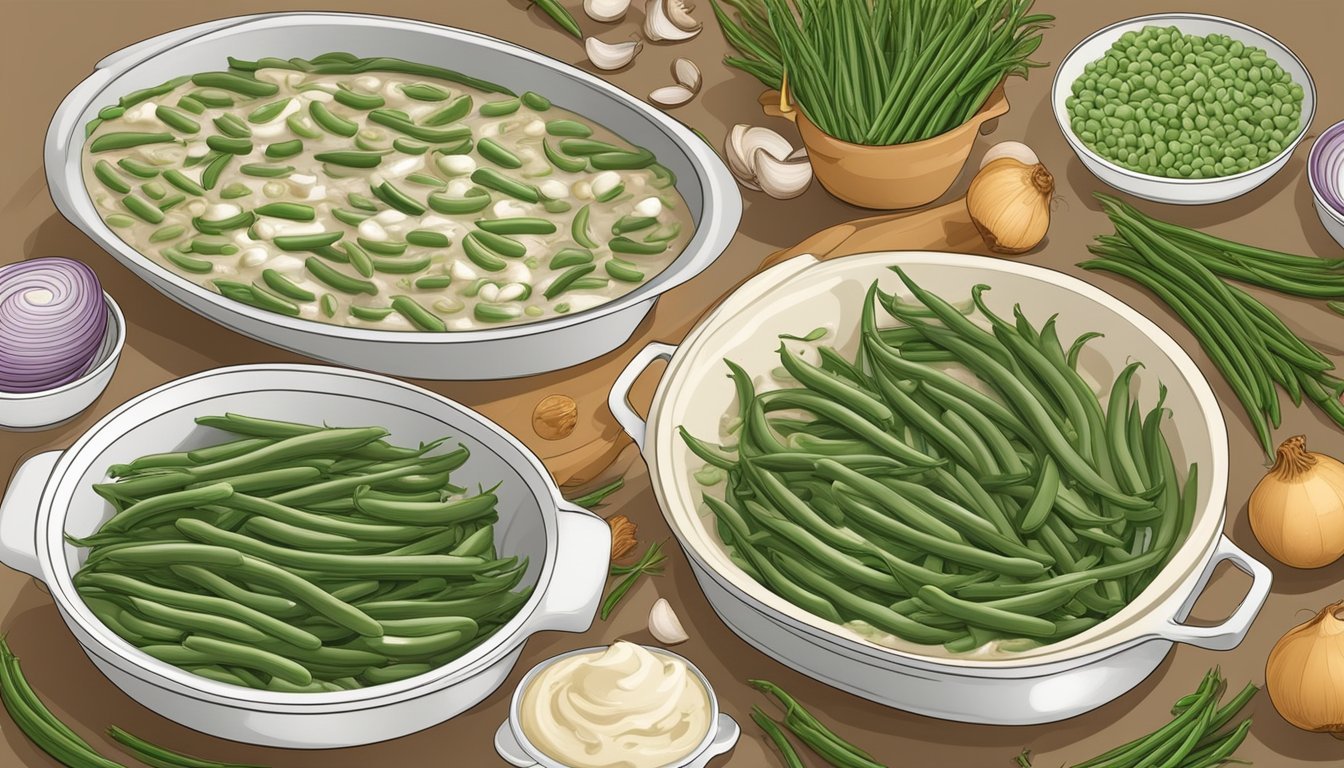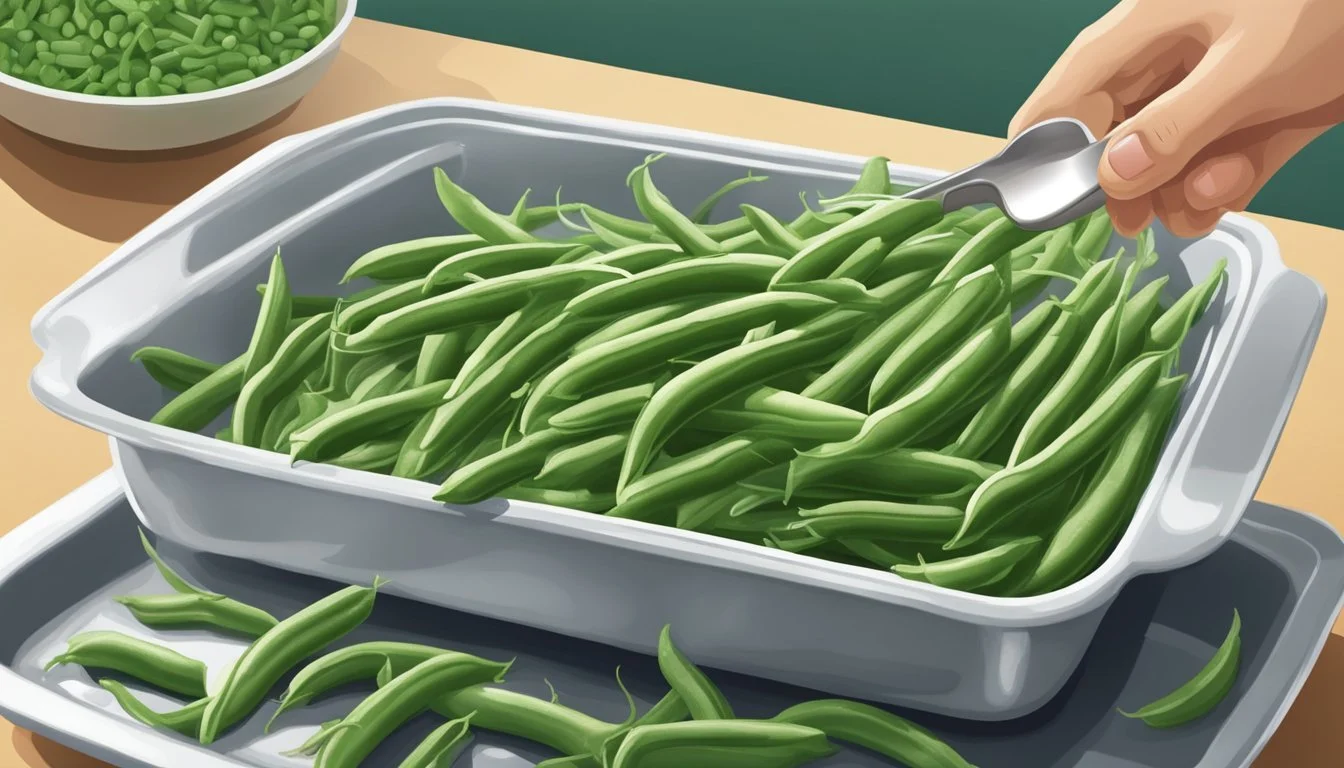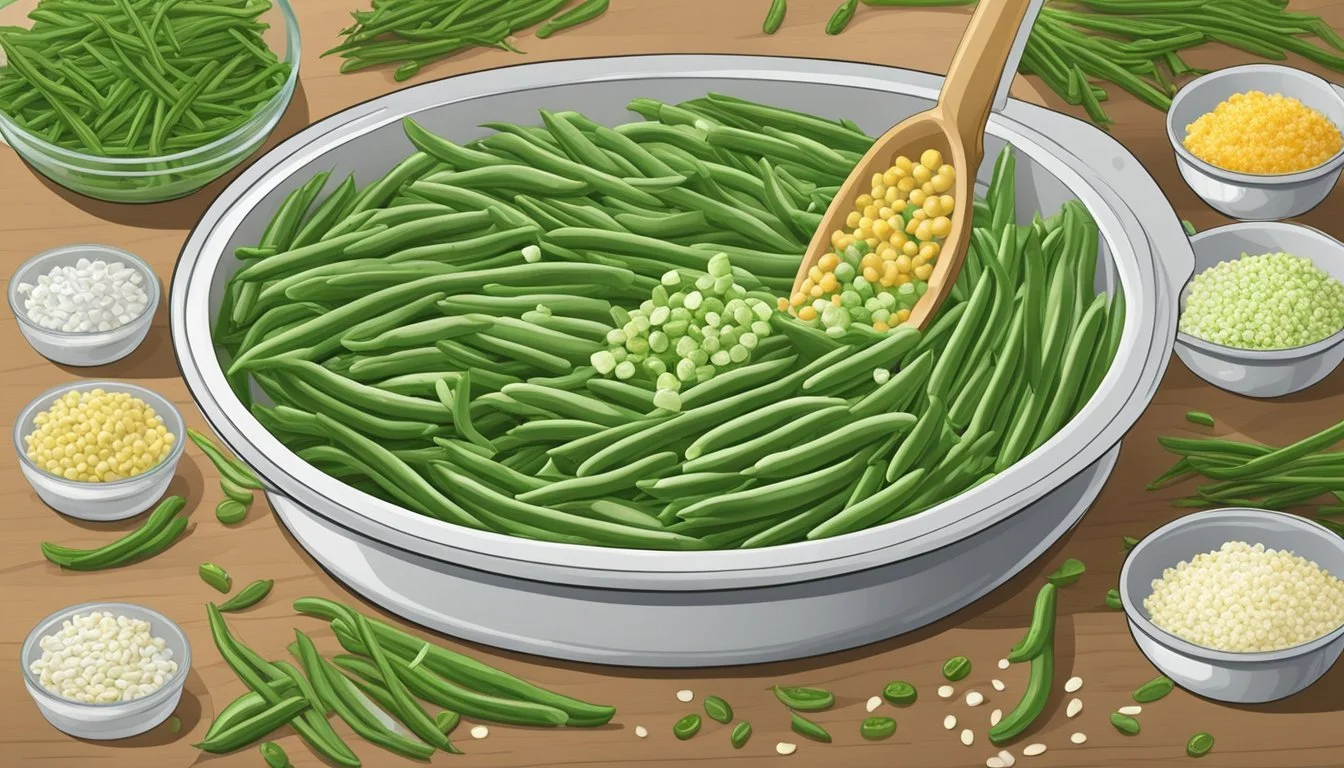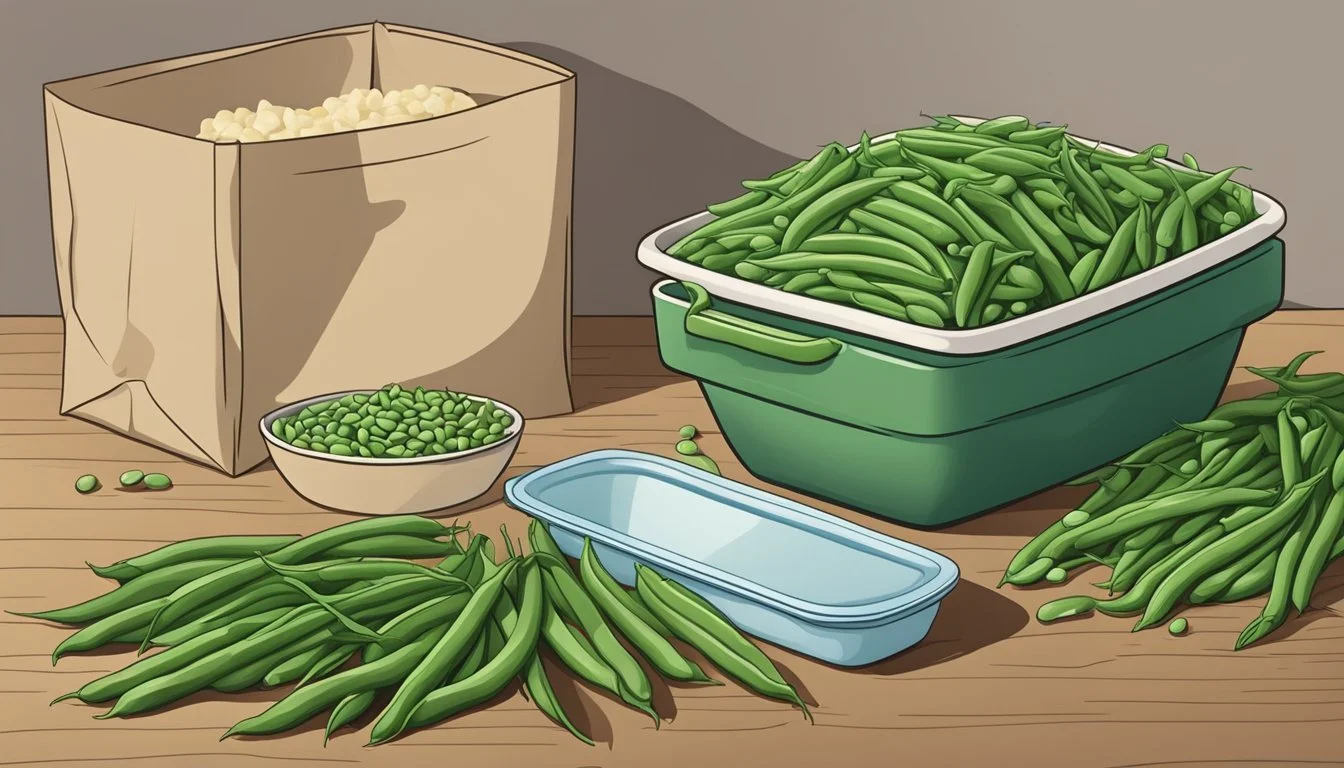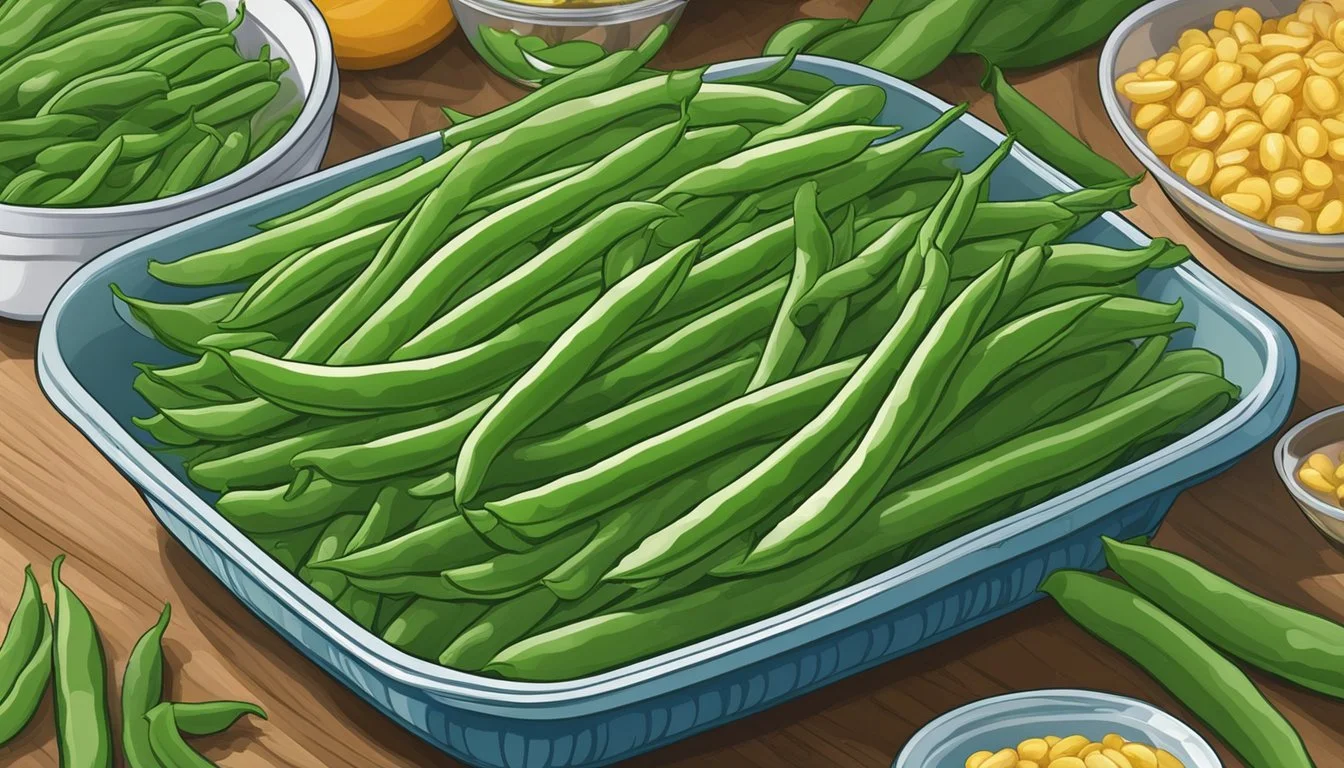Fresh vs. Frozen Green Beans: Perfecting Your Casserole Recipe
Green bean casserole is a beloved comfort food dish, especially popular during holidays and family gatherings. When preparing this classic recipe, many cooks find themselves wondering whether to use fresh or frozen green beans. Both options can yield delicious results, but there are some key differences to consider.
Fresh green beans generally provide a crisper texture and brighter flavor in casseroles, while frozen beans offer convenience and year-round availability. Fresh beans require a bit more prep work, including washing, trimming, and cutting. Frozen beans come pre-cleaned and cut, saving time in the kitchen.
For those prioritizing taste and texture, fresh green beans are often the preferred choice. They maintain their shape and vibrant color better during cooking. Frozen beans, on the other hand, can sometimes become softer in the casserole. Ultimately, the decision between fresh and frozen green beans comes down to personal preference, time constraints, and seasonal availability.
Choosing Green Beans
When making green bean casserole, the type of green beans you select can significantly impact the dish's taste and texture. Fresh, frozen, and canned options each have distinct characteristics that affect the final result.
Fresh Green Beans
Fresh green beans offer the crispest texture and brightest flavor. Look for beans that are firm, vibrant green, and snap easily when bent. Avoid any with brown spots or limp appearance.
Preparation involves washing, trimming the ends, and cutting to desired length. Blanch fresh beans briefly in boiling water before adding to the casserole to maintain their color and crunch.
Fresh beans require more prep time but provide superior taste and texture. They're ideal for those who prefer a firmer bite in their casserole.
Frozen Green Beans
Frozen green beans offer convenience without sacrificing much quality. They're typically flash-frozen at peak freshness, preserving nutrients and flavor.
No washing or trimming is needed. Simply thaw and drain before use. Frozen beans often have a softer texture than fresh but firmer than canned.
They're a great year-round option when fresh beans aren't available. Frozen beans work well in casseroles, providing consistent results with minimal effort.
Canned Green Beans
Canned green beans are the most convenient option but have the softest texture. They're pre-cooked and ready to use straight from the can.
Drain and rinse canned beans to reduce sodium content. Their soft texture works well in creamy casseroles but may become mushy if overcooked.
Canned beans are shelf-stable and always available. They're suitable for quick, last-minute casseroles but may lack the vibrant color and crisp texture of fresh or frozen options.
Preparation Basics
Proper preparation is crucial for a delicious green bean casserole. Whether using fresh or frozen beans, certain steps ensure optimal texture and flavor.
Cleaning and Trimming
Fresh green beans require cleaning and trimming before use. Rinse them thoroughly under cold water to remove any dirt or debris. Snap off the stem ends and remove any tough strings along the sides. For uniform cooking, cut longer beans into 1-2 inch pieces.
Frozen green beans are pre-cleaned and trimmed, saving time and effort. However, inspect them for any ice crystals or freezer burn before use.
Blanching Method
Blanching is essential for fresh green beans to preserve color and texture. Bring a large pot of salted water to a boil. Add the beans and cook for 3-4 minutes until bright green and crisp-tender.
Immediately transfer the beans to an ice bath to stop the cooking process. This maintains their vibrant color and prevents overcooking.
Drain well before using in the casserole.
Preparation Times
Fresh green beans typically require 10-15 minutes for cleaning and trimming. Blanching adds another 5-7 minutes to the prep time.
Frozen green beans need about 5 minutes to thaw at room temperature or can be used directly from the freezer.
Total prep time for fresh beans: 15-22 minutes Total prep time for frozen beans: 0-5 minutes
Consider these time differences when planning your meal preparation.
Creating the Casserole Base
The foundation of a great green bean casserole lies in its creamy base. Three popular options include mushroom cream sauce, creamy mushroom sauce, and roux-based cream sauce. Each offers a unique flavor profile and texture to complement the green beans.
Mushroom Cream Sauce
Mushroom cream sauce starts with sautéing sliced mushrooms in butter until golden brown. Add minced garlic and cook for another minute. Pour in heavy cream and simmer until slightly thickened. Season with salt and pepper to taste.
This sauce provides a rich, earthy flavor that pairs well with both fresh and frozen green beans. The chunks of mushrooms add texture and depth to the casserole.
For extra flavor, consider using a mix of mushroom varieties like cremini, shiitake, and white button mushrooms.
Creamy Mushroom Sauce
Creamy mushroom sauce combines the convenience of canned cream of mushroom soup with additional ingredients for enhanced flavor. Mix the soup with milk or chicken broth to reach desired consistency.
Sauté diced onions and sliced mushrooms in butter before stirring them into the soup mixture. This adds fresh elements to the canned base.
Season with garlic powder, black pepper, and soy sauce for umami depth. The result is a quick and easy sauce that still offers homemade touches.
Roux-Based Cream Sauce
A roux-based cream sauce starts with equal parts butter and flour. Melt butter in a saucepan and whisk in flour to create a paste. Cook for 1-2 minutes to remove the raw flour taste.
Slowly whisk in milk or a combination of milk and chicken broth. Simmer until thickened, stirring constantly. Add sautéed mushrooms and onions for flavor and texture.
Season with salt, pepper, and garlic powder. This sauce offers complete control over flavor and thickness, ideal for those who prefer to make everything from scratch.
Seasoning and Flavor Enhancements
Proper seasoning and flavor enhancements can elevate a green bean casserole from ordinary to extraordinary. The right combination of spices and ingredients brings out the best in both fresh and frozen green beans.
Salt and Pepper Essentials
Salt and pepper form the foundation of seasoning for green bean casserole. Kosher salt is preferred by many chefs for its pure flavor and ability to adhere well to foods. It enhances the natural taste of green beans without overpowering them.
Black pepper adds a subtle heat and complexity. Freshly ground pepper provides the most vibrant flavor. For best results, season the green beans before adding them to the casserole.
Soy sauce can be used as an alternative to salt, offering a deeper umami flavor. A small amount goes a long way in boosting the overall taste profile of the dish.
Additional Flavorings
Beyond salt and pepper, various herbs and spices can complement green beans beautifully. Garlic powder or minced fresh garlic adds a savory note that pairs well with the vegetable's earthy flavor.
Onion powder or finely diced onions contribute sweetness and depth. Thyme and rosemary offer aromatic qualities that elevate the dish.
For a touch of richness, consider adding grated Parmesan cheese or a splash of Worcestershire sauce. These ingredients enhance the casserole's complexity without overwhelming the green beans.
Experiment with different combinations to find your preferred flavor profile. Remember to taste as you go, adjusting seasonings to suit your palate.
Combining Ingredients
Proper layering and cheese incorporation are crucial for creating a delicious green bean casserole. These techniques ensure even distribution of flavors and textures throughout the dish.
Layering Components
Start by spreading a thin layer of the creamy mushroom sauce in the bottom of the casserole dish. This prevents the green beans from sticking and adds flavor to every bite. Place half of the green beans on top of the sauce.
Pour half of the remaining sauce over the beans. Sprinkle a layer of crispy fried onions for added crunch and flavor. Repeat with another layer of green beans and sauce.
For extra richness, add a layer of shredded cheddar cheese before the final layer of crispy onions. This creates pockets of melted cheese throughout the casserole.
Incorporating Cheese
Cheese adds depth and creaminess to green bean casserole. Mix shredded cheddar cheese directly into the mushroom sauce for a more uniform cheesy flavor. Alternatively, create distinct layers of cheese between the green beans.
For a crispy top, combine grated Parmesan cheese with panko breadcrumbs. Sprinkle this mixture over the casserole before baking. The Parmesan adds a savory note while the breadcrumbs provide a golden, crunchy texture.
When using cheese, consider the moisture content of the casserole. Fresh green beans may release more water during cooking, so using a drier cheese like aged cheddar can help maintain the desired consistency.
Topping Variations
The topping is a crucial element that adds texture and flavor to green bean casserole. Different options can transform the dish, providing crunch, savory notes, or cheesy goodness.
Crispy Fried Onions
French fried onions are the classic topping for green bean casserole. These crispy, golden morsels add a satisfying crunch and savory flavor. Canned fried onions are convenient and readily available in most grocery stores.
For a homemade touch, thinly sliced onions can be dredged in flour and fried until golden brown. This method allows control over seasoning and oil use.
Some recipes suggest adding the onions halfway through baking to prevent burning. Others recommend sprinkling them on top during the last 5-10 minutes of cooking for maximum crispiness.
Breadcrumb Options
Breadcrumbs offer a crunchy alternative to fried onions. Regular breadcrumbs can be mixed with melted butter and herbs for a flavorful topping.
Panko breadcrumbs provide an extra-crispy texture. They can be toasted in a skillet with butter and garlic for added flavor before topping the casserole.
For a gluten-free option, crushed gluten-free crackers or cornflakes can be used. These alternatives maintain the desired crunch while accommodating dietary restrictions.
Some recipes combine breadcrumbs with grated Parmesan cheese for a savory twist. This mixture can be sprinkled over the casserole before baking.
Cheese Infusions
Adding cheese to the topping creates a rich, gooey layer. Shredded cheddar is a popular choice, melting into a golden crust.
Gruyère or Swiss cheese can provide a nutty flavor. These cheeses pair well with sautéed mushrooms in the casserole.
For a tangy twist, crumbled blue cheese or feta can be sprinkled on top. These strong cheeses should be used sparingly to avoid overpowering the dish.
Some recipes suggest mixing cheese with the crispy onions or breadcrumbs. This combination creates a flavorful, textured topping that browns beautifully in the oven.
Baking the Casserole
Baking is the final step in creating a delicious green bean casserole. Proper oven preparation, cooking times, and temperature control are crucial for achieving the perfect texture and flavor.
Oven Preparation
Preheat the oven to 350°F (175°C). This temperature ensures even cooking throughout the casserole. Place the oven rack in the middle position for optimal heat distribution.
Grease a 9x13-inch baking dish with butter or cooking spray. This prevents sticking and makes serving easier.
Transfer the prepared green bean mixture to the baking dish. Spread it evenly to promote consistent cooking.
Cooking Times and Temperatures
Bake the casserole uncovered at 350°F for 30-35 minutes. This allows the flavors to meld and the top to become golden brown.
For a crispier top, increase the temperature to 400°F for the last 5 minutes of baking.
If using a glass baking dish, reduce the temperature by 25°F to prevent overcooking the edges.
Checking for Doneness
Look for a golden brown top and bubbling edges. These are key indicators that the casserole is ready.
Insert a knife into the center of the casserole. It should come out hot, indicating the dish is heated through.
The internal temperature should reach 165°F (74°C) for food safety. Use a food thermometer to check.
Let the casserole rest for 5-10 minutes before serving. This allows the sauce to set and makes serving easier.
Nutritional Considerations
Green bean casserole can be a nutritious dish, with the choice between fresh and frozen beans impacting its overall nutritional profile. The preparation methods and additional ingredients also play key roles in determining the final nutritional value.
Calorie and Macronutrient Content
Fresh green beans contain about 31 calories per 100 grams, while frozen varieties typically have around 28 calories. Both options are low in calories and fat, making them suitable for weight management.
Green beans provide a good source of dietary fiber, with about 2.7 grams per 100-gram serving. They offer moderate amounts of carbohydrates and protein.
Fresh green beans contain slightly more vitamin C than their frozen counterparts. However, frozen beans often retain more B vitamins due to the quick freezing process after harvest.
Low-Fat and Low-Sodium Options
Traditional green bean casserole recipes can be high in fat and sodium due to ingredients like cream of mushroom soup and fried onions. Opting for low-fat cream soups or making a homemade sauce with skim milk can significantly reduce fat content.
Using fresh mushrooms instead of canned varieties helps lower sodium levels. Choosing low-sodium broths and limiting added salt during preparation further reduces overall sodium content.
Substituting crispy baked onions for fried ones cuts down on fat while maintaining flavor and texture. This simple swap can make a notable difference in the casserole's nutritional profile.
Storage and Make-Ahead Tips
Proper storage and preparation techniques are crucial for maintaining the quality and safety of green bean casserole ingredients. Following these guidelines ensures optimal freshness and convenience.
Refrigeration Guidelines
Fresh green beans can be stored in the refrigerator for up to 7 days. Place them unwashed in a plastic bag with small holes for ventilation. For prepared casserole components, store cooked green beans and sauce separately in airtight containers for up to 3 days.
Assembled but unbaked casseroles can be refrigerated for 24-48 hours. Cover tightly with plastic wrap or foil. Allow the dish to come to room temperature before baking.
Freezing and Thawing
Green bean casserole freezes well, making it ideal for make-ahead meals. Freeze unbaked casseroles for up to 3 months. Wrap tightly in plastic wrap and foil, or use freezer-safe containers.
To thaw, transfer the frozen casserole to the refrigerator 24-48 hours before baking. Remove plastic wrap and bake as directed, adding 15-20 minutes to the cooking time if still partially frozen.
Leftovers Handling
Refrigerate leftover green bean casserole within 2 hours of cooking. Store in airtight containers for up to 4 days. Reheat individual portions in the microwave or larger amounts in the oven at 350°F until heated through.
For best quality, consume leftovers within 3-4 days. If reheating from frozen, thaw in the refrigerator overnight and bake at 350°F until hot and bubbly, about 20-30 minutes.
Alternative Cooking Methods
Green bean casserole can be prepared using methods beyond traditional oven baking. These alternative approaches offer flexibility and convenience while maintaining the dish's classic flavors.
Slow Cooker Adaptation
Slow cookers provide an effortless way to prepare green bean casserole. Place fresh or frozen green beans in the slow cooker. Mix cream of mushroom soup, milk, and seasonings in a bowl, then pour over the beans. Cook on low for 4-5 hours or high for 2-3 hours. Stir occasionally to ensure even cooking.
Add crispy fried onions during the last 30 minutes to prevent sogginess. This method frees up oven space and allows for easy transport to potlucks or gatherings.
Stovetop Variation
A stovetop version offers a quicker alternative to traditional baking. Start by sautéing sliced mushrooms and onions in a large skillet. Add fresh or thawed green beans and cook until tender-crisp.
Stir in cream of mushroom soup and milk, simmering until the mixture thickens. Top with crispy fried onions just before serving. This method reduces cooking time and provides more control over the bean's texture.
For added crunch, toast the fried onions separately in a small pan before sprinkling them on top.
Serving Suggestions
Green bean casserole is a versatile side dish that enhances many meals. It pairs well with various main courses and shines during holiday gatherings. Thoughtful presentation can elevate this classic dish to new heights.
Pairing with Main Courses
Green bean casserole complements roasted meats beautifully. It's an ideal accompaniment to turkey, ham, or prime rib. The creamy texture and savory flavors balance well with grilled chicken or pork chops. For weeknight dinners, serve it alongside meatloaf or baked chicken.
Vegetarian mains like lentil loaf or stuffed portobello mushrooms also pair nicely. The casserole's richness adds depth to plant-based meals. Consider serving it with quinoa-stuffed bell peppers or roasted vegetable tart for a satisfying meat-free dinner.
Holiday Serving Ideas
Thanksgiving and Christmas dinners often feature green bean casserole. Place it near the turkey, stuffing, and mashed potatoes on the holiday table. Its creamy texture contrasts nicely with cranberry sauce.
For Easter, serve it alongside glazed ham or roasted lamb. At potlucks, green bean casserole is a crowd-pleaser. Use a slow cooker to keep it warm during buffet-style gatherings.
For New Year's Eve parties, create mini portions in ramekins for an elegant touch. This allows guests to sample multiple dishes without overloading their plates.
Presentation and Garnishing
Elevate the appearance of green bean casserole with thoughtful presentation. Transfer it to a decorative casserole dish before serving. Sprinkle extra crispy fried onions on top just before bringing it to the table.
Garnish with fresh herbs like thyme or parsley for a pop of color. Toasted sliced almonds add crunch and visual appeal. For a gourmet touch, drizzle truffle oil over individual portions.
Use a wide serving spoon to dish out neat portions. Place a small bowl of extra fried onions nearby for guests who enjoy extra crunch. Consider serving on a bed of mixed salad greens for an attractive plated option.
Casserole Variations and Alternatives
Green bean casserole is a beloved classic, but there are many ways to put a twist on this dish or explore other comforting casserole options. Creative variations and vegetarian alternatives offer something for every palate.
Other Popular Casseroles
Sweet potato casserole is a holiday favorite, combining mashed sweet potatoes with a crunchy pecan topping. Corn casserole blends creamed corn, whole kernels, and cornbread mix for a rich side dish. Cheese lovers can indulge in a cheesy potato casserole, layering sliced potatoes with cheddar and a creamy sauce.
For meat enthusiasts, chicken and rice casserole offers a hearty one-dish meal. Tuna noodle casserole remains a budget-friendly comfort food staple. Breakfast casseroles featuring eggs, cheese, and various mix-ins are perfect for brunch gatherings.
Vegetarian and Vegan Options
Vegetarian green bean casserole can be made by swapping traditional cream of mushroom soup for a plant-based alternative. Mushroom and wild rice casserole provides earthy flavors and satisfying textures. Lentil and vegetable casserole offers a protein-packed meal without meat.
Vegan options include butternut squash and kale casserole, using nutritional yeast for a cheesy flavor. Eggplant parmesan casserole layers breaded eggplant with tomato sauce and vegan cheese. Cauliflower and broccoli casserole creates a creamy dish using cashew-based sauce.
These plant-based alternatives use ingredients like breadcrumbs, nuts, or crispy onions to add crunch, mimicking the texture of traditional casseroles.


